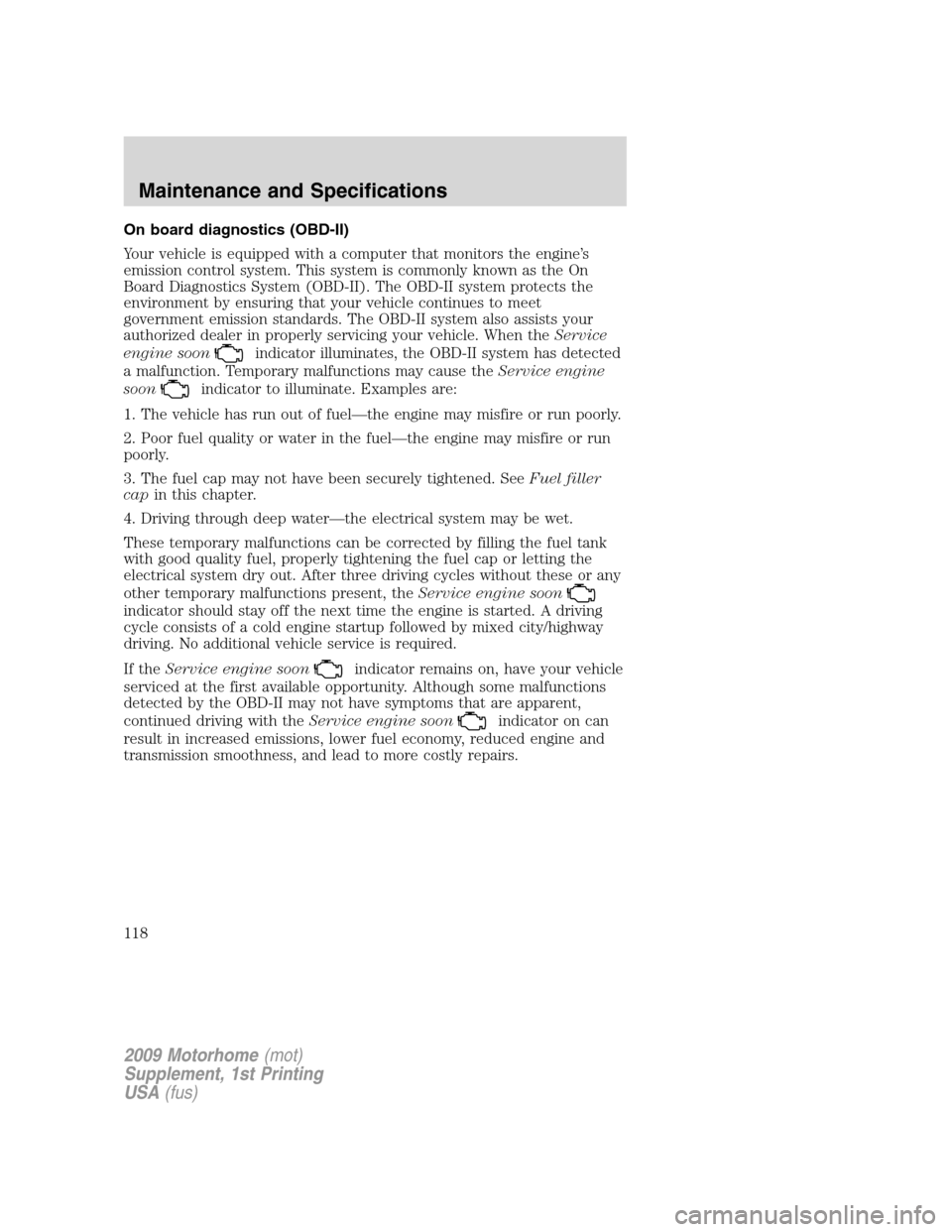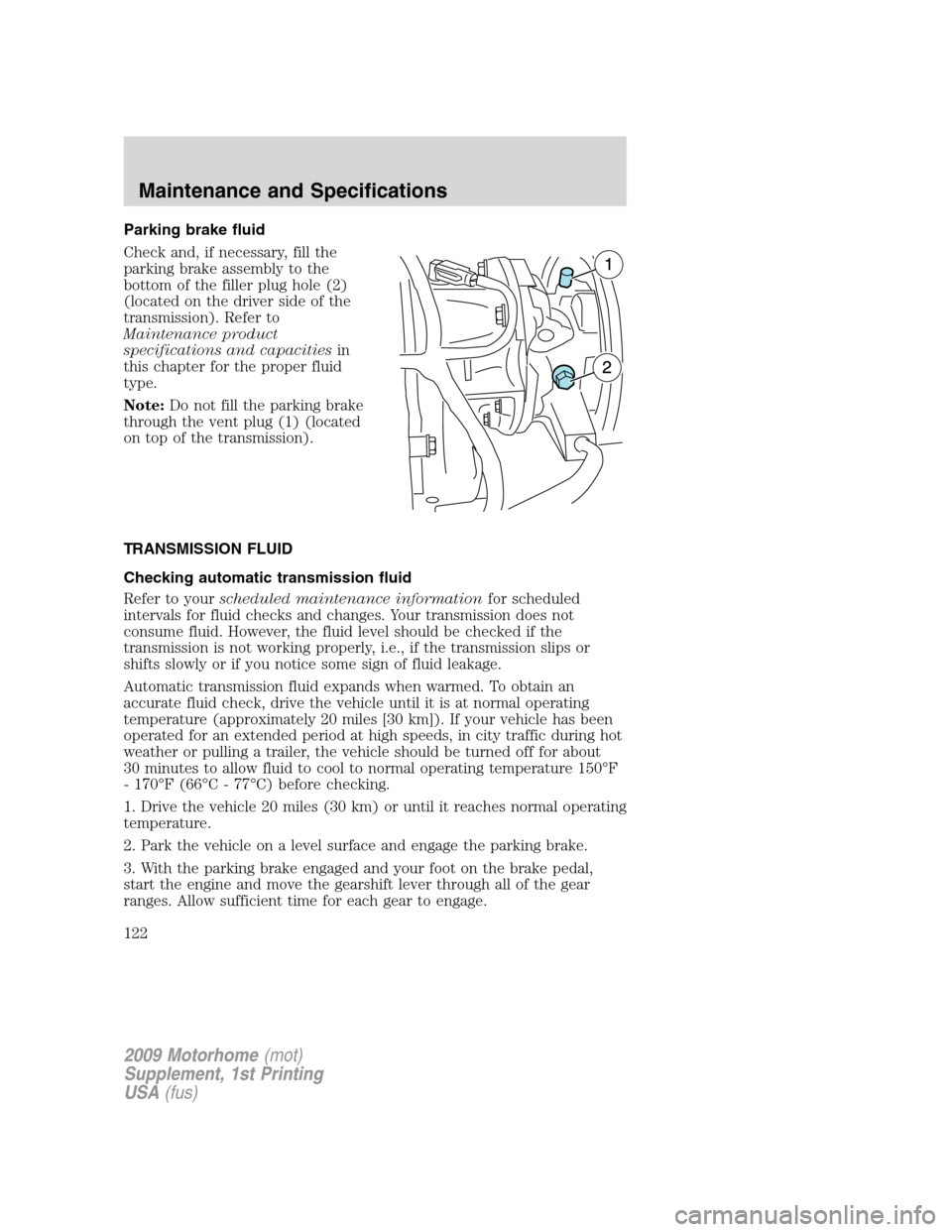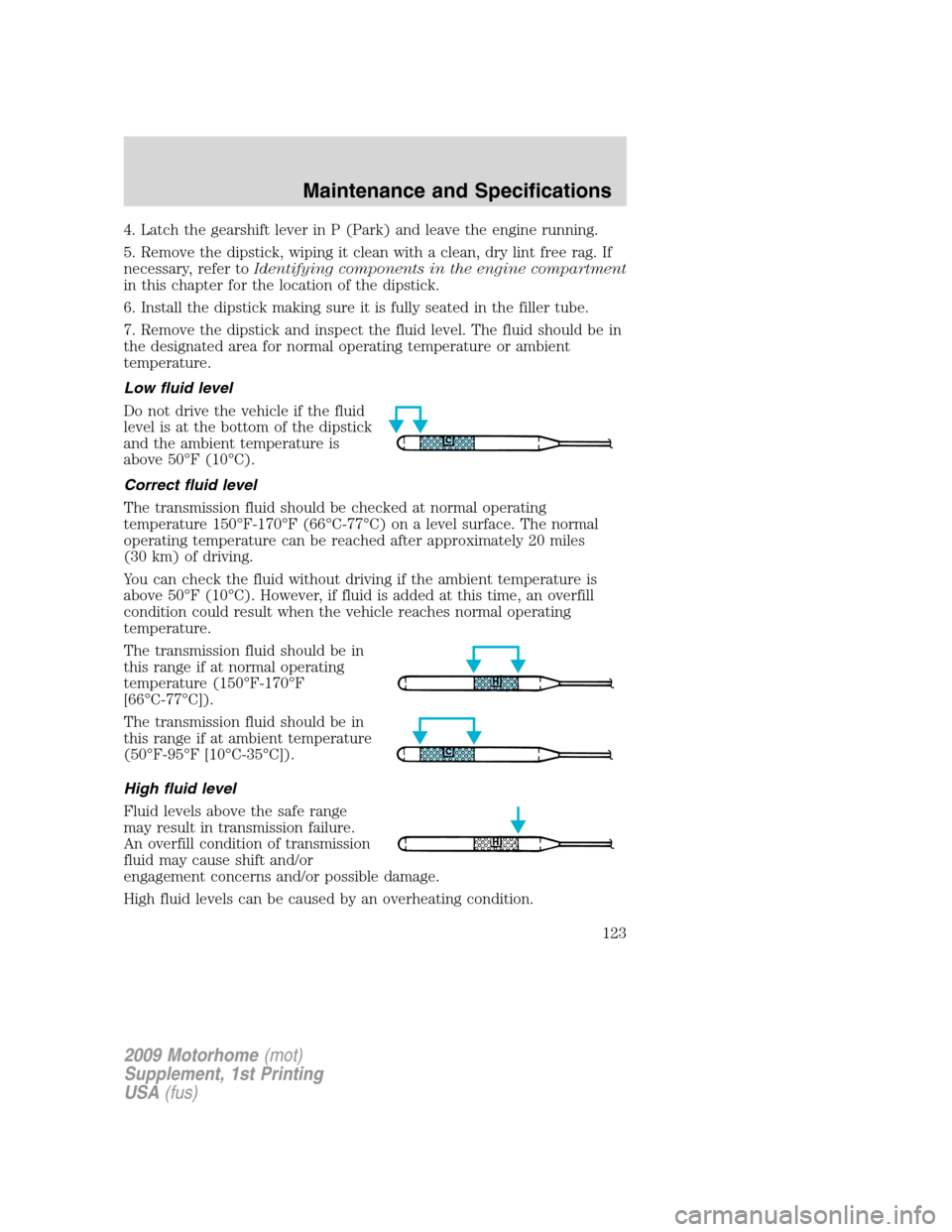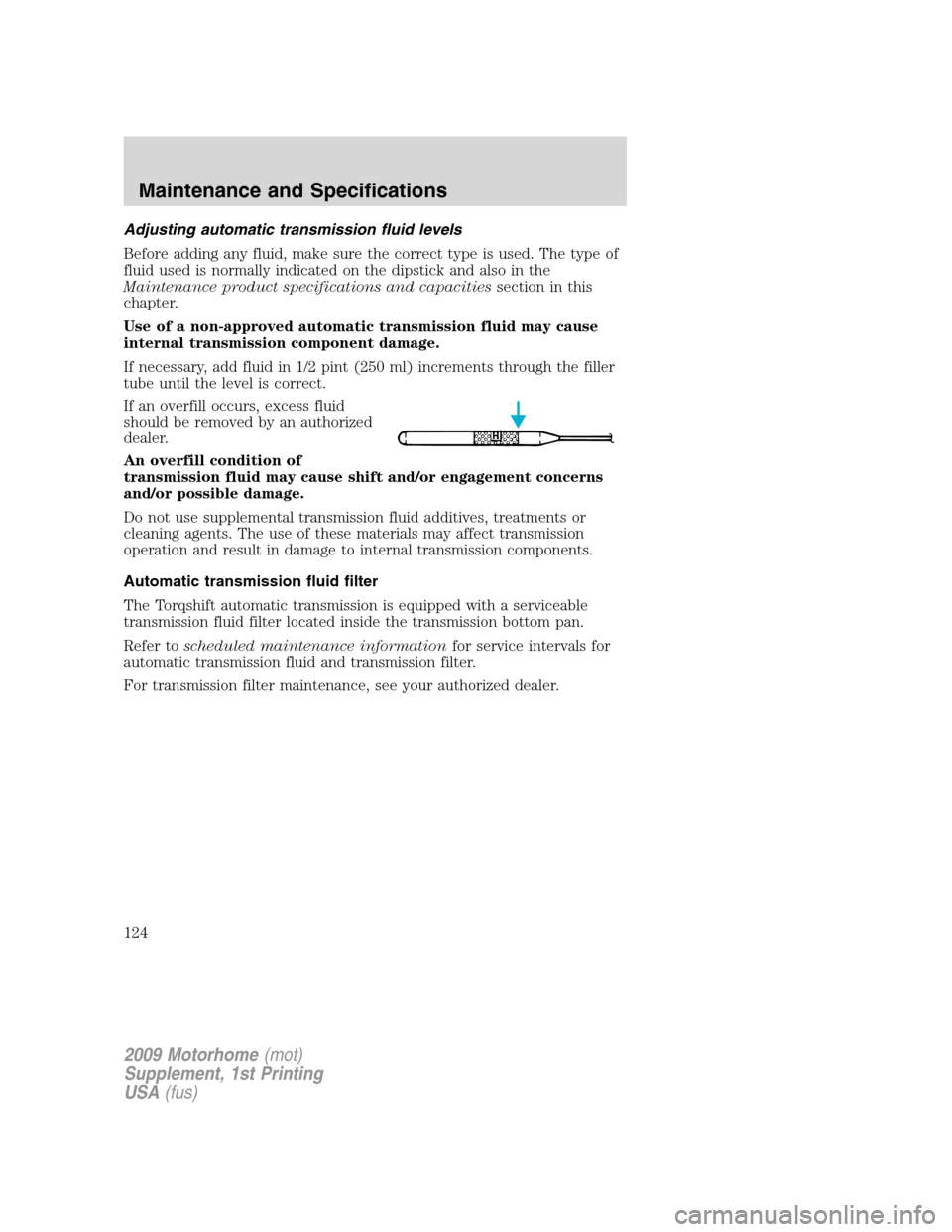Page 118 of 136

On board diagnostics (OBD-II)
Your vehicle is equipped with a computer that monitors the engine’s
emission control system. This system is commonly known as the On
Board Diagnostics System (OBD-II). The OBD-II system protects the
environment by ensuring that your vehicle continues to meet
government emission standards. The OBD-II system also assists your
authorized dealer in properly servicing your vehicle. When theService
engine soon
indicator illuminates, the OBD-II system has detected
a malfunction. Temporary malfunctions may cause theService engine
soon
indicator to illuminate. Examples are:
1. The vehicle has run out of fuel—the engine may misfire or run poorly.
2. Poor fuel quality or water in the fuel—the engine may misfire or run
poorly.
3. The fuel cap may not have been securely tightened. SeeFuel filler
capin this chapter.
4. Driving through deep water—the electrical system may be wet.
These temporary malfunctions can be corrected by filling the fuel tank
with good quality fuel, properly tightening the fuel cap or letting the
electrical system dry out. After three driving cycles without these or any
other temporary malfunctions present, theService engine soon
indicator should stay off the next time the engine is started. A driving
cycle consists of a cold engine startup followed by mixed city/highway
driving. No additional vehicle service is required.
If theService engine soon
indicator remains on, have your vehicle
serviced at the first available opportunity. Although some malfunctions
detected by the OBD-II may not have symptoms that are apparent,
continued driving with theService engine soon
indicator on can
result in increased emissions, lower fuel economy, reduced engine and
transmission smoothness, and lead to more costly repairs.
2009 Motorhome(mot)
Supplement, 1st Printing
USA(fus)
Maintenance and Specifications
118
Page 122 of 136

Parking brake fluid
Check and, if necessary, fill the
parking brake assembly to the
bottom of the filler plug hole (2)
(located on the driver side of the
transmission). Refer to
Maintenance product
specifications and capacitiesin
this chapter for the proper fluid
type.
Note:Do not fill the parking brake
through the vent plug (1) (located
on top of the transmission).
TRANSMISSION FLUID
Checking automatic transmission fluid
Refer to yourscheduled maintenance informationfor scheduled
intervals for fluid checks and changes. Your transmission does not
consume fluid. However, the fluid level should be checked if the
transmission is not working properly, i.e., if the transmission slips or
shifts slowly or if you notice some sign of fluid leakage.
Automatic transmission fluid expands when warmed. To obtain an
accurate fluid check, drive the vehicle until it is at normal operating
temperature (approximately 20 miles [30 km]). If your vehicle has been
operated for an extended period at high speeds, in city traffic during hot
weather or pulling a trailer, the vehicle should be turned off for about
30 minutes to allow fluid to cool to normal operating temperature 150°F
- 170°F (66°C - 77°C) before checking.
1. Drive the vehicle 20 miles (30 km) or until it reaches normal operating
temperature.
2. Park the vehicle on a level surface and engage the parking brake.
3. With the parking brake engaged and your foot on the brake pedal,
start the engine and move the gearshift lever through all of the gear
ranges. Allow sufficient time for each gear to engage.
2009 Motorhome(mot)
Supplement, 1st Printing
USA(fus)
Maintenance and Specifications
122
Page 123 of 136

4. Latch the gearshift lever in P (Park) and leave the engine running.
5. Remove the dipstick, wiping it clean with a clean, dry lint free rag. If
necessary, refer toIdentifying components in the engine compartment
in this chapter for the location of the dipstick.
6. Install the dipstick making sure it is fully seated in the filler tube.
7. Remove the dipstick and inspect the fluid level. The fluid should be in
the designated area for normal operating temperature or ambient
temperature.
Low fluid level
Do not drive the vehicle if the fluid
level is at the bottom of the dipstick
and the ambient temperature is
above 50°F (10°C).
Correct fluid level
The transmission fluid should be checked at normal operating
temperature 150°F-170°F (66°C-77°C) on a level surface. The normal
operating temperature can be reached after approximately 20 miles
(30 km) of driving.
You can check the fluid without driving if the ambient temperature is
above 50°F (10°C). However, if fluid is added at this time, an overfill
condition could result when the vehicle reaches normal operating
temperature.
The transmission fluid should be in
this range if at normal operating
temperature (150°F-170°F
[66°C-77°C]).
The transmission fluid should be in
this range if at ambient temperature
(50°F-95°F [10°C-35°C]).
High fluid level
Fluid levels above the safe range
may result in transmission failure.
An overfill condition of transmission
fluid may cause shift and/or
engagement concerns and/or possible damage.
High fluid levels can be caused by an overheating condition.
2009 Motorhome(mot)
Supplement, 1st Printing
USA(fus)
Maintenance and Specifications
123
Page 124 of 136

Adjusting automatic transmission fluid levels
Before adding any fluid, make sure the correct type is used. The type of
fluid used is normally indicated on the dipstick and also in the
Maintenance product specifications and capacitiessection in this
chapter.
Use of a non-approved automatic transmission fluid may cause
internal transmission component damage.
If necessary, add fluid in 1/2 pint (250 ml) increments through the filler
tube until the level is correct.
If an overfill occurs, excess fluid
should be removed by an authorized
dealer.
An overfill condition of
transmission fluid may cause shift and/or engagement concerns
and/or possible damage.
Do not use supplemental transmission fluid additives, treatments or
cleaning agents. The use of these materials may affect transmission
operation and result in damage to internal transmission components.
Automatic transmission fluid filter
The Torqshift automatic transmission is equipped with a serviceable
transmission fluid filter located inside the transmission bottom pan.
Refer toscheduled maintenance informationfor service intervals for
automatic transmission fluid and transmission filter.
For transmission filter maintenance, see your authorized dealer.
2009 Motorhome(mot)
Supplement, 1st Printing
USA(fus)
Maintenance and Specifications
124
Page 127 of 136
MOTORCRAFT PART NUMBERS
Component 6.8L V10 engine
Air filter element FA-1782
Battery BXT-65-750
Fuel filter FG-872
Oil filter FL-820-S
Spark plugs *
Transmission fluid filter FT-180
*For spark plug replacement, see your authorized dealer. Refer to
scheduled maintenance informationfor the appropriate intervals for
changing the spark plugs.
Replace the spark plugs with ones that meet Ford material and
design specifications for your vehicle, such as Motorcraft or
equivalent replacement parts. The customer warranty may be
void for any damage to the engine if such spark plugs are not
used.
2009 Motorhome(mot)
Supplement, 1st Printing
USA(fus)
Maintenance and Specifications
127
Page 129 of 136

Item Capacity Ford Part NameFord Part
Number / Ford
Specification
Engine coolant30.6 quarts
(29.0L)
1
Motorcraft
Premium Gold
Engine Coolant
with bittering
agent
(yellow-colored)
2
VC-7-B /
WSS-M97B51-A1
Cooling system
stop leak pellets—Motorcraft
Cooling System
Stop Leak PelletsVC-6 /
WSS-M99B37-B6
Engine oil6.0 quarts
(5.7L)Motorcraft SAE
5W-20 Premium
Synthetic Blend
Motor Oil (US)
Motorcraft SAE
5W-20 Super
Premium Motor
Oil (Canada)XO-5W20-QSP
(US)
CXO-5W20-LSP12
(Canada) /
WSS-M2C930-A
with API
Certification
Mark
Automatic
transmission
Torqshift 5-speed18.2 quarts
(17.2L)
3
Motorcraft
MERCON�LV
AT F
4
XT-10-QLV /
MERCON�LV
WSS-M2C938-A
Power steering
fluidKeep in
FULL range
on dipstick
Motorcraft
MERCON�VATFXT-5-QM /
MERCON�V
Parking brake
assemblyFill to bottom
of fill plug
hole
Rear Axle
Dana 804.0 quarts
(3.9L)
5
Motorcraft SAE
75W-140
Synthetic Rear
Axle LubricantXY-75W140-QL /
WSL-M2C192-A
and GL-5
2009 Motorhome(mot)
Supplement, 1st Printing
USA(fus)
Maintenance and Specifications
129
Page 130 of 136

Item Capacity Ford Part NameFord Part
Number / Ford
Specification
Rear Axle
Dana S1107.0 quarts
(6.6L)
6
Motorcraft SAE
75W-140
Synthetic Rear
Axle LubricantXY-75W140-QL /
WSL-M2C192-A
and GL-5
Rear Axle
Dana S1307.0 quarts
(6.6L)
5
Motorcraft SAE
75W-140
Synthetic Rear
Axle LubricantXY-75W140-QL /
WSL-M2C192-A
and GL-5
Rear Axle
Dana Spicer
17060S16.0 quarts
(15.1L)Motorcraft SAE
75W-140
Synthetic Rear
Axle LubricantXY-75W140-QL /
WSL-M2C192-A
and GL-5
Transmission
/steering/parking
brake linkages
and pivots, brake
and clutch pedal
shaft (if
equipped)—Premium
Long-Life GreaseXG-1-C /
ESA-M1C75-B
Fuel tank75.0 gallons
(284.0L)——
1Capacity is approximate and will vary due to second-stage manufacturer
completion of HVAC system. Fill to the Cold Fill Level on reservoir.
2Add the coolant type originally equipped in your vehicle.
3Indicates only approximate dry-fill capacity. Some applications may vary
based on cooler size and if equipped with in-tank cooler. The amount of
transmission fluid and fluid level should be set by the indication on the
dipstick’s normal operating range.
4Automatic transmissions that require MERCON�LV should only use
MERCON�LV fluid. Refer toscheduled maintenance informationto
determine the correct service interval. Use of any fluid other than the
recommended fluid may cause transmission damage.
5Fill 1/4 inch to 9/16 inch (6 mm to 14 mm) below bottom of fill hole.
2009 Motorhome(mot)
Supplement, 1st Printing
USA(fus)
Maintenance and Specifications
130
Page 132 of 136
The Vehicle Identification Number (VIN) contains the following
information:
1. World manufacturer identifier
2. Brake system / Gross Vehicle
Weight Rating (GVWR) / Restraint
System
3. Vehicle line, series, body type
4. Engine type
5. Check digit
6. Model year
7. Assembly plant
8. Production sequence number
TRANSMISSION CODE DESIGNATIONS
You can find a transmission code on
the Safety Compliance Certification
Label. The following table tells you
which transmission each code
represents.
Description Code
Five-speed automatic, TorqShift T
2009 Motorhome(mot)
Supplement, 1st Printing
USA(fus)
Maintenance and Specifications
132